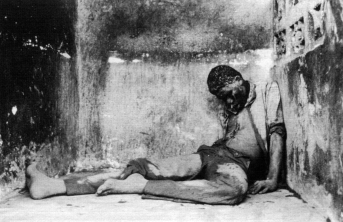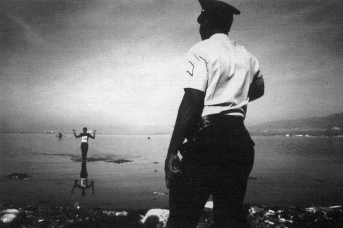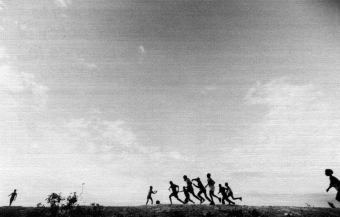
Maggie Steber: Artist in Haiti Between Heaven and Hell
Roger Bergman
Director of the Justice and Peace Studies Program
The "best pictures I ever took," in award-winning photojournalist Maggie Steber's own estimation, were formal portraits of Haitian peasants, "the sweetest, most beautiful, most courageous people" she has met in her extensive world travels. While her dramatic news photos of Haitian life--and death--since the fall of Jean-Claude "Baby Dec" Duvalier in 1986 have won many awards from professional and academic institutions and have earned assignments from such journals as National Geographic, Life, The New York Times, U.S. News & World Report, Newsweek, and The Independent (London), perhaps Steber's fondness for those formal portraits of the poorest of this hemisphere's poor tells us more about her as a humanist-artist of the camera.
Maggie Steber was on the Creighton campus September 8 to discuss the politics of Haiti and the ethics of photojournalism. The Center for the Study of Religion and Society and the Justice and Peace Studies Program sponsored her two-hour slide-lecture to a rapt audience of 100 students, faculty, staff, and townspeople. Steber was in Omaha to attend the opening of an exhibit of her work at the Bemis Center for Contemporary Arts and the Garden of the Zodiac Gallery. Her Creighton presentation and the exhibit drew on her 1992 book from Aperture, Dancing on Fire: Photographs from Haiti.
 |
||||
| Photos by Maggie Steber, 1991 A man shot and killed by Tonton Macoutes or the Haitian Army is propped up as a warning to Haitians against voting in the November 1987 elections. Photo used by permission of the photographer. |
||||
Only one of the sixty photographs in this portfolio comes from what must have been a remarkable series of formal sittings Steber conducted in a rural village in Haiti, where she worked extensively through the late 1980s and early 90s. What made those portraits especially meaningful to Steber was that they were done at the request of the peasants themselves. Always sensitive to the possible tension between photojournalist and human subject, whose "newsworthiness" may be the result of grisly tragedy, Steber was delighted to be asked to take a photo of a young woman and her three children. One request led to many and soon everyone in the village was decked out in their finest and lined up for a turn before Steber's respectful, even reverential, camera.
But that's not the whole story. Back in her home in New York City, and at her own expense, Steber made prints for all her peasant subjects. When she returned to distribute them in Haiti, the villagers' response, according to Steber, was "incredible." A pig--as close as these people get to wealth--was killed and roasted in celebration. Thus did Maggie Steber, humanist and artist, occasion a joyful feast in the midst of misery by making possible her friends' dignified self-presentation on film.
One is reminded of President Jean-Bertrand Aristide's promise to the vast majority of Haiti's people, the base of his political support: "From misery to poverty with dignity." Maggie Steber's photographs and her comments on them made it clear she understands what he means . . . and why that promise has electrified the populace.
Most of Steber's photos are considerably more disturbing than her subtly evocative portrait of that village family, a bright red hibiscus blossom at the proud mother's throat. A stunning portrait of three Port-au-Prince street children--"boy-men," she called them--shows them shoulder-to-shoulder against a rough wooden background. The entire photo is etched in shades of gun-metal grey, deep bronze, and a black grainy with texture. "Grim" hardly does justice to the tone of the portrait or to the expressions--and probable futures--of those portrayed. And yet Steber's comments at Creighton on September 8 made it clear these children were still just that, despite their street-smarts learned in the daily struggle for survival against all odds.
She knows these orphans by name, as well she might. Much of her Creole she learned from them. And, without elaboration, Steber mentioned that they had saved her life. Her book includes the comment that machetes have been at her throat.
A more typical teenager's prankish grin is captured in Steber's informal portrait of Wildek, proud owner of cheap sunglasses, a young slum-dweller she is helping to put through school. It's obvious no formal permission to shoot was required.
 |
||||
| Photo by Maggie Steber, 1991 Moments after this photo was taken, the Haitian policeman shot and killed the man with his hands up. Photographer Steber's sensitivity caused her to eschew showing such a photo, but this one was published around the world. Used with permission of the photographer. |
||||
But what about the family in mourning at the funeral of one of their own, a victim of military violence during the December, 1987 elections? Permission was asked and granted, with the explanation, "We want our story to be told." And told compellingly it is. Six adults, dressed mainly in shades of blue, surround, hold up, lead on, two boys in immaculate white shirts, the one in the center appealing directly to us through anguished, glistening tears. A father, one presumes, was slain on his way to the polls.
No permission is necessary--or possible--from several of Steber's subjects. They are dead, victims of military repression or the mayhem of the "attaches". One can hardly imagine a more exquisite photograph of a more gruesome subject than her portrait in turquoise and muted purple of a muddled corpse propped in a corner as a warning of the price one pays to vote in the Haiti of the dictators. Its visceral eloquence transforms that corpse into testimony to the humanity of the dead.
Steber admitted to not "getting" Haiti her first several times there.
Only with the insight that the island nation was a "gateway between heaven and hell" was she able to organize her perceptions. "Being in Haiti," she writes, "is like angels and demons all dancing on the head of a pin and somehow you are mixed up with them." Only a religious vision, she implies, can begin to explain the reality of Haiti.
Steber's formal presentation at Creighton concluded, as does her book, on a diabolical note. A Haitian policeman, pistol drawn but at his side, stands on garbage on a beach (presumably near one of the capitol city's massive slums), his broad uniformed back to us, looking out to the water. A small figure, a youngish man, his arms up in surrender, is walking toward us ankle-deep in the water. He is wearing black pants and a black tee-shirt with a white square on his chest, like a target. Discovered committing a theft, he had tried to swim to safety. The policeman is waiting.
But there is no picture, no potential prizewinner--according to her colleagues back at the hotel in the hills above the city where Steber later recounted the incident--there is no photo of the aim, cock, and fire, no photo of the exploding target, of the extra-judicially-executed petty-thief falling backwards into the filthy water. Let Maggie Steber herself explain why not:
"Some days you make deals with God and the devil and whomever else you can . . . There in the sunlight, the children play. But in the shadow or just around the corner or across the street or in the car that speeds by, evil and all its sentries lurk. There can be nothing innocent. There can be only this epic battle. Some days you just can't take the picture."
Maybe she was being irresponsible as a journalist, Maggie admitted to wondering. Maybe she was professionally negligent in not telling the whole story. But maybe she has told the story, by ellipsis. Maybe, some days, in order to tell the truth, the fragile, awful, human truth, you just can't take the picture. Composition, composure, would be something of a lie. That's quite an admission for a photojournalist who obviously takes great pride in her work.
 |
||||
| Photo by Maggie Steber, 1988 Foretold Future? Children play on a bladed, deforested hill outside Port-au- Prince, Haiti. Used with permission of the photographer. |
||||
But it's equally obvious that there's more to Maggie Steber's photographic account of life and death in contemporary Haiti than the highest level of professional artistry. As I believe her captivated Creighton audience would attest, there is also a profound, unsentimental, and even heroic humanity in her photography. Maggie Steber, in her passionate and compassionate way, like the Haitian people she photographs with such reverence, seems to be "dancing on fire."